| |
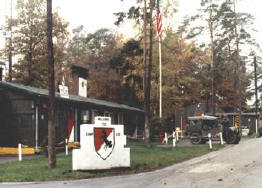
Introduction
to Camp Lee
Bob Stefanowicz / Ted Prescott / Erwin Ritter
The Eaglehorse border camp dates back
to the early days of the Cold War with the assignment of the 2/14 ACR to Daley Barracks and the beginning of the border surveillance
mission. The camp, as of 1951, existed as a small patrol base and
FM radio relay station. Of the four different 14th ACR yearbooks I
have seen, 1952, 54, 55 and 1960, none offer text or photos
related to the border camps.
Camp Wollbach was built in
stages, it first existed as a "tent city" to support a squad or
two. Then as the mission evolved, continuing gradual improvements
occurred as the mission evolved and materials and funds became
available. The 14th ACR web site reports that the first group of
semi permanent buildings was put up in the mid 1960s from "depot
scrounged" materials that became available as NATO forces withdrew
from France. During this period, the camp was first configured to
support an entire cavalry troop deployed from Daley Barracks.
Click on the pictures below to view the
stories
|
The camp was renamed Camp Lee in 1976
in honor of 1LT Phillip L. Lee. This is his story . . .
|
Camp
Lee Open House
1987 or 1988? |
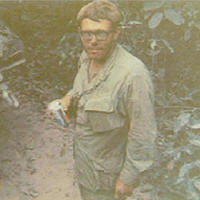 |
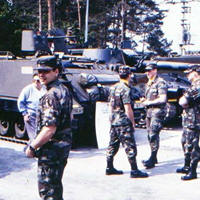 |
| |
|
Eaglehorse troopers would
remember these buildings as the operations center which also held
the briefing area and "old mess hall", the beer hall, day room and
arms room. Quonset Hut style barracks buildings were added in this
same period and in due course, they were replaced with the blue,
pre - fabricated buildings in the early 1970s. The motor shop,
concrete hardstand and paved roads were improvements that also
date from about 1970. The last major addition to Camp Lee from my
period was in early 1978 with the opening of the "new" dining
facility.
Staffing at the camp changed
as time and circumstances allowed. As of 1980, the camp had a full
time custodian assigned from HHT. He lived on site and was
responsible for the physical plant as well as providing some
oversight to the other HHT personnel, usually two medics in the
small dispensary and the border wheel vehicle mechanic. The mess
team, responsible for the property and operation of the dining
facility, came from the consolidated mess at Daley. The contents
of the camp were inventoried and transferred from troop to battery
to company in the normal 30 day rotation cycle. Facility Engineers
at Daley were called for building problems above the ability of
the custodian. Seemingly each tour ended with Reports of Survey
initiated to resolve damages to the sheet rock walls of the pre-fab
buildings.
Ted Prescott, former E Troop
commander and Squadron Border Officer from the mid 1980s picks up
the story: Many improvements were made at Camp Lee during my time
with the Eaglehorse. The SCO, LTC Ramick, implemented several
changes in which we received new barracks, a new beer hall
complete with a four foot tall hand carved wooden Blackhorse
statue, a motor pool makeover and a patio cookout area outside of
the dining facility. As of December of 86, planning was underway
for further improvements to include a new Border Operations Center
and a new building to house the Reaction Force, Medics and
additional administrative space. Construction had not yet begun.
Erwin Ritter of the BGS
follows: In the late 1980s, big changes again were made at Camp
Lee. The "new" Border Operations Center was built next to the
motor shop building and a tall mast to improve FM radio
communications was added. The " old " border operations center
first was used as storage space and then was torn down. Just as
the border mission ended, construction
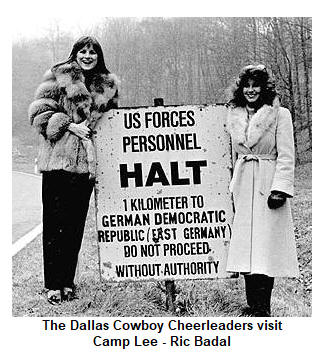 was completed on the "new"
gate guard building at the entrance and a new building for the
Reaction Force and Camp Lee Dispensary. U.S. forces never used
these last two buildings. This was the sequence of events; in
November 1989, the border began to open, March 1990, the last use
of Camp Lee for Eaglehorse border operations, U.S. patrol was only
intermittently run directly from Daley Barracks. In May 1991, a
big open house was held and within a month or two, the squadron
cleared all property from the camp and it was shuttered.
Negotiations began for the return of the site to German control. was completed on the "new"
gate guard building at the entrance and a new building for the
Reaction Force and Camp Lee Dispensary. U.S. forces never used
these last two buildings. This was the sequence of events; in
November 1989, the border began to open, March 1990, the last use
of Camp Lee for Eaglehorse border operations, U.S. patrol was only
intermittently run directly from Daley Barracks. In May 1991, a
big open house was held and within a month or two, the squadron
cleared all property from the camp and it was shuttered.
Negotiations began for the return of the site to German control.
For thousands of troopers
who passed through Camp Wollbach / Camp Lee in support of the
border mission, the memories of the beer hall, of returning from
US patrol in the dead of Winter and middle of the night to find
hot rations saved, championship horse shoes after formation, USO
shows dropping in as well as VIPs from USAREUR, squeezing a
cavalry troop on to the hardstand then rolling flawlessly out on
alert ... of patrol briefings at 0430 and driving the camp OIC to
the OP for a post midnight check, of high stakes poker with the
platoon sergeants and being packed into the troop billets to see
the Barrier Fence system for the first time the next day ... of
gate guard duty and roving guard with a PRC 77, terrible movies
handed off at the southern contact point to the first
"interesting" movies on VHS tape shown by invitation only in the
Learning Center and the siren system calling the Reaction Force to
alert .. these are among the most vivid and satisfying memories we
troopers share.
Update for Border
Camp site
All things change and so to
with the site of Camp Wollbach - Camp Lee. Once the camp area was
returned to German control, it saw a variety of new uses: a hub
for German Boy Scout activity, home for refugees from the East
after all the old borders opened, a proposed site for a local
museum recalling the East - West German border and now, the site
of a local German paint ball venue. The camp has been segmented by
a temporary fence, the buildings built in the waning days of U. S.
control are off limits to the club, but at least some of the pre-fab barracks buildings and other older “temporary structures”
associated with the camp are now pock marked with hundreds of red
and yellow paint ball impacts.
|
Click on
the thumbnail to view the full-sized photo |
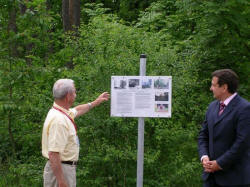
LTC (Ret) Mac Van Hook left and
Mayor of Heustreu at placing of Grenztafel at site of Camp
Wollbach - Lee in Summer 2005. |
|

In English and German, through
words and images, the story of the camp and the U.S. Army was
recalled. The poster was part of a larger German program
throughout the former border area to recall the history of the
Cold War and inter - German border barrier system. |
|
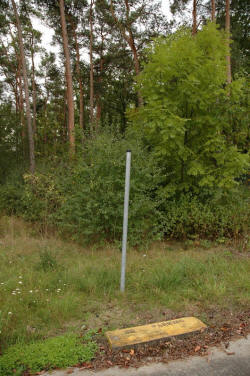
The Grenztafel is currently
missing. |
| |
|
|
|
|
The Grenztafel placed just
outside of the camp during the
11th - 14th
ACR German reunion in 2005 that provided an explanation of the U.
S. Army’s use of the area in words and images has gone missing.
All of this does not bode well for the future. If the old border
camp has reached this level of use, then the wrecker’s ball cannot
be too far off but such is the odd way that swords are fashioned
to plow shares and spears go to pruning hooks.
|
Click on
the thumbnail to view the associated slide show |
|
|
|
|
|
|
Camp Lee in the Later Years
|
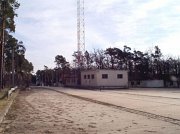 |
|
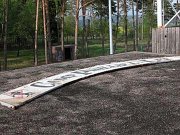 |
|
 |
| |
|
|
|
|
(revised Oct 2017) |
|